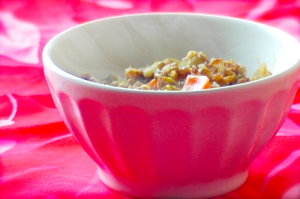Cleansing Healing Kitchari

Prep time
Cook time
Total time
Kitchari is a healing dish made from rice and mung beans and lightly spiced with ginger, cilantro, and other spices. In Ayurveda, it is considered a fasting food and is used to purify digestion and cleanse systemic toxins. Kitchari provides comfort and nourishment while allowing the body to put its energy towards healing. You can safely eat kitchari anytime in order to build vitality and strength as it helps balance all three doshas. For anxious vata, the warm soup is grounding; for fiery pitta, its spices are calming; and for cool kapha, it provides healing warmth. Kitchari can give the digestion a much needed break while still providing essential nutrients. The blend of rice and mung beans offers a balanced but easy-to-digest protein source and its mixture of spices aids in digestion. Add your favourite veggies to create a new variation every time. Here is a recipe that I really enjoy. I usually add cauliflower, sweet potato, kale and anything else that might be floating around in my fridge.
Author: Cathy Russell
Serves: 6
Ingredients
- 1 cup brown basmati rice (soaked 8 hours)
- ½ cup whole mung beans (soaked 8 hours)
- 2 tbsp coconut oil
- 1 large onion chopped
- 2 tsp grated ginger
- 1 garlic clove, minced
- ½ tsp turmeric
- ½ tsp cardamom
- ¼ tsp ground cloves
- ¾ tsp cinnamon
- 1 cup chopped cilantro
- ¼ cup chopped mint leaves
- 3 medium tomatoes, chopped
- 4 cups water or more
- 2 tsp Himalayan salt, or to taste
- 3 to 4 cups chopped veggies (try 2 or more of the following: kale, spinach, sweet potato, zucchini, cauliflower, peas, carrots, fennel, etc.)
Instructions
- Soak brown rice and mung beans together for about 8 hours, drain and rinse.
- In a large pot, heat coconut oil and sauté onions, garlic, ginger and spices** gently for about 10 minutes.
- Add cilantro, mint and tomatoes, stirring for about 3 minutes.
- Add drained rice, mung beans, water and salt. Cook on medium low heat for 40 minutes.
- Add cauliflower and other vegetables if desired and simmer for 20 more minutes* until vegetables are tender and rice is quite soft, adding more water as necessary. *Time-saving Tip #1: Sometimes I steam my vegetables separately while the mung beans and rice are cooking and then just add them in at the end when the beans and rice are cooked. Then I just allow the flavours to incorporate for a few more minutes and dig in.**Time saving tip #2: When you have a daunting list of spices in your recipe, simply get a little prep bowl and bring it over to your spice rack. Grab a set of measuring spoons and start going through all of the spices with the appropriate measurement and with speed and focus. This will take all of 2 minutes and will save you time and aggravation, and mistakes too. Once everything is measured out, simply dump the spices into the pot or bowl when instructed.Recipe adapted from Enlightened Eating, by Caroline Marie Dupont.
Recipe by at https://www.cathyrussellcreativenutrition.com/cleansing-healing-kitchari/